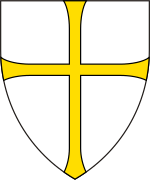Steinkjer
Steinkjer is a municipality in Trøndelag county, Norway. It is part of the Innherad region. The administrative centre of the municipality is the town of Steinkjer which is located on the inner part of the Trondheimsfjord. The town is also the administrative centre for Trøndelag county. Other populated areas in Steinkjer include the villages of Ogndal, Hyllbrua, Gaulstad, Beitstad, Bartnes, Vellamelen, Stod, Binde, Sunnan, Byafossen, Følling, Kvam, Lerkehaug, Mære, Sparbu, Vassaunet, Vekre, Malm, Follafoss, Sela, and Verrastranda.
Steinkjer kommune | |
|---|---|
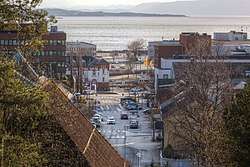 Central Steinkjer in mid-April 2015 | |
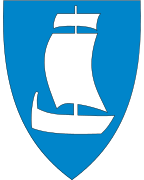 Coat of arms 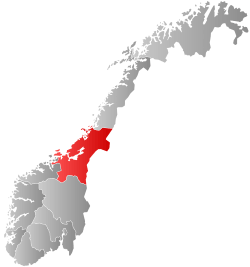 Trøndelag within Norway | |
 Steinkjer within Trøndelag | |
| Coordinates: 64°03′29″N 11°43′08″E | |
| Country | Norway |
| County | Trøndelag |
| District | Innherad |
| Established | 23 Jan 1858 |
| Administrative centre | Steinkjer |
| Government | |
| • Mayor (2019) | Anne Berit Lein (Sp) |
| Area | |
| • Total | 2,122.06 km2 (819.33 sq mi) |
| • Land | 1,937.20 km2 (747.96 sq mi) |
| • Water | 184.86 km2 (71.37 sq mi) 8.7% |
| Area rank | 31 in Norway |
| Population (2020) | |
| • Total | 24,357 |
| • Rank | 49 in Norway |
| • Density | 12.6/km2 (33/sq mi) |
| • Change (10 years) | 2.4% |
| Demonym(s) | steinkjerbygg[1] |
| Time zone | UTC+01:00 (CET) |
| • Summer (DST) | UTC+02:00 (CEST) |
| ISO 3166 code | NO-5006 |
| Official language form | Neutral[2] |
| Website | steinkjer |
The 2,122-square-kilometre (819 sq mi) municipality is the 31st largest by area out of the 356 municipalities in Norway. Steinkjer is the 49th most populous municipality in Norway with a population of 24,357. The municipality's population density is 12.6 inhabitants per square kilometre (33/sq mi) and its population has increased by 2.4% over the previous 10-year period.[3][4]
General information
The village of Steinkjer in the municipality of Stod was declared a kjøpstad (town) in 1857, and then on 23 January 1858 it was separated from Stod to form a municipality of its own. The initial population of Steinkjer was 1,150.
Over time, as the town grew, land was annexed from the neighboring municipalities. It started on 1 January 1902 when an unpopulated area from the neighboring Ogndal municipality was taken for future growth of Steinkjer. Then in 1941, an area (population: 57) was taken from Ogndal to be added to Steinkjer. Again, in 1948, an area (population: 78) was transferred from Ogndal and another area (population: 70) was transferred from Egge municipality.
During the 1960s, there were many municipal mergers across Norway due to the work of the Schei Committee. On 1 January 1964, a large merger took place: the neighboring municipalities of Beitstad (population: 2,563), Egge (population: 3,476), Kvam (population: 1,245), Ogndal (population: 2,678), Sparbu (population: 4,027), and Stod (population: 1,268) were all merged with the town of Steinkjer (population: 4,325) to form the new municipality of Steinkjer.[5]
On 1 January 2018, the municipality switched from the old Nord-Trøndelag county to the new Trøndelag county.
On 1 January 2020, the municipality of Steinkjer and the neighboring municipality of Verran merged to form a new, larger municipality of Steinkjer.[6]
Toponymy
The municipality (and town) is named after the old Steinkjer farm (Old Norse: Steinker), since the town is built on the site of the old farm. The first element is steinn (m) which means "stone" or "rock". The last element is ker (n) which means a "barrier made for catching fish".[7]
Coat of arms
The coat of arms was approved in October 2018 for use in 2020 after the merger of Steinkjer and Verran municipalities. The arms were formerly the arms of Verran Municipality from 1987 until 2019. The arms show a blue background with a silver verranjekt, a type of boat that is common in the area. The arms were designed by Rolf Tidemann.[8][9]
The old coat of arms was granted on 8 March 1957 and used through 2019. The arms showed a silver star with six points on a blue background. The original meaning of the star was that six main roads crossed in Steinkjer. After the municipal reorganization of 1964, the arms were re-granted, but the meaning has slightly changed. Steinkjer now formed the centre of the municipality and the points are directed to the six other districts in the municipality: Beitstad, Egge, Kvam, Ogndal, Sparbu, and Stod.[10]
 Current arms since 1 January 2020
Current arms since 1 January 2020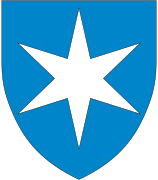 Arms used from 1957 until 2019
Arms used from 1957 until 2019
Churches
The Church of Norway has nine parishes (sokn) within the municipality of Steinkjer. It is part of the Nord-Innherad prosti (deanery) in the Diocese of Nidaros.
| Parish (sokn) | Church name | Location | Year built |
|---|---|---|---|
| Beitstad | Beitstad Church | Beitstad | 1869 |
| Bartnes Church | Bartnes | 1960 | |
| Egge | Egge Church | Egge in Steinkjer | 1767 |
| Følling | Følling Church | Følling | 1726 |
| Henning | Henning Church | Vekre | 1872 |
| Kvam | Kvam Church | Kvam | 1878 |
| Malm | Malm Church | Malm | 1885 |
| Sela Church | Sela | 1997 | |
| Mære | Mære Church | Mære | c. 1150 |
| Ogndal | Skei Church | Ogndal | 1664 |
| Bodom Church | Bodom | 1905 | |
| Steinkjer | Steinkjer Church | Steinkjer | 1965 |
| Stod | For Church | Stod | 1846 |
| Verran | Follafoss Church | Follafoss | 1954 |
History
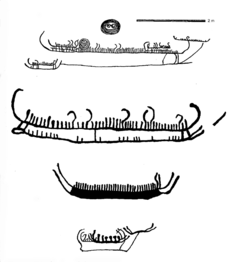
The Steinkjer area has been populated since the Stone Age, as shown by the Bølareinen rock carving, which depicts an almost life-sized reindeer and a bear. There are other rock carvings in the area as well, as in Bardal, the oldest up to 6,000 years old.
The Steinkjer area was one of the strongest powerbases in early Viking Age. Mære was one of the best known Norse religious places with sacrifices and seasonal gatherings (Norwegian: Hov) before Christianity came to Norway.

Steinkjer has survived two major disasters in modern history. The first was a town-wide fire in the year 1900, which burned down much of the southern parts of the town. The second disaster happened on 21 and 22 April 1940, when the town was struck by Luftwaffe bombers during the Norwegian Campaign. Most of the town was destroyed, but no lives were lost.[11]
The attack destroyed a large part of Steinkjer, and many priceless historical buildings, such as the old, cruciform Steinkjer Church were lost. The town was, however, quickly rebuilt after 1945 with much aid from the United States. Much of the architecture of modern Steinkjer originates from the 1950s and 1960s with architecture inspired by functionalism rather than the aestheticism of the earlier Art Nouveau style to be seen in such cities as Trondheim and Ålesund. A few historical buildings – for example, the railway station and the town's college – survived the bombing. These are buildings based on the neoclassical architectural style known as Jugendstil. Good examples are the aforementioned railway station (jernbanestasjonen) and the administration building of Nord-Trøndelag University College (Norwegian: Høgskolen i Nord-Trøndelag).
Government
All municipalities in Norway, including Steinkjer, are responsible for primary education (through 10th grade), outpatient health services, senior citizen services, unemployment and other social services, zoning, economic development, and municipal roads. The municipality is governed by a municipal council of elected representatives, which in turn elect a mayor.[12] The municipality falls under the Inntrøndelag District Court and the Frostating Court of Appeal.
Municipal council
The municipal council (Kommunestyre) of Steinkjer is made up of 47 representatives that are elected to four year terms. The party breakdown of the council is as follows:
| Party Name (in Norwegian) | Number of representatives | |
|---|---|---|
| Labour Party (Arbeiderpartiet) | 13 | |
| Progress Party (Fremskrittspartiet) | 2 | |
| Green Party (Miljøpartiet De Grønne) | 1 | |
| Conservative Party (Høyre) | 3 | |
| Red Party (Rødt) | 3 | |
| Centre Party (Senterpartiet) | 22 | |
| Socialist Left Party (Sosialistisk Venstreparti) | 2 | |
| Liberal Party (Venstre) | 1 | |
| Total number of members: | 47 | |
| Party Name (in Norwegian) | Number of representatives | |
|---|---|---|
| Labour Party (Arbeiderpartiet) | 17 | |
| Progress Party (Fremskrittspartiet) | 2 | |
| Green Party (Miljøpartiet De Grønne) | 2 | |
| Conservative Party (Høyre) | 3 | |
| Christian Democratic Party (Kristelig Folkeparti) | 1 | |
| Centre Party (Senterpartiet) | 19 | |
| Socialist Left Party (Sosialistisk Venstreparti) | 2 | |
| Liberal Party (Venstre) | 1 | |
| Total number of members: | 47 | |
| Party Name (in Norwegian) | Number of representatives | |
|---|---|---|
| Labour Party (Arbeiderpartiet) | 18 | |
| Progress Party (Fremskrittspartiet) | 4 | |
| Conservative Party (Høyre) | 4 | |
| Christian Democratic Party (Kristelig Folkeparti) | 1 | |
| Centre Party (Senterpartiet) | 16 | |
| Socialist Left Party (Sosialistisk Venstreparti) | 2 | |
| Liberal Party (Venstre) | 2 | |
| Total number of members: | 47 | |
| Party Name (in Norwegian) | Number of representatives | |
|---|---|---|
| Labour Party (Arbeiderpartiet) | 17 | |
| Progress Party (Fremskrittspartiet) | 7 | |
| Conservative Party (Høyre) | 3 | |
| Christian Democratic Party (Kristelig Folkeparti) | 1 | |
| Centre Party (Senterpartiet) | 14 | |
| Socialist Left Party (Sosialistisk Venstreparti) | 3 | |
| Liberal Party (Venstre) | 2 | |
| Total number of members: | 47 | |
| Party Name (in Norwegian) | Number of representatives | |
|---|---|---|
| Labour Party (Arbeiderpartiet) | 16 | |
| Progress Party (Fremskrittspartiet) | 5 | |
| Conservative Party (Høyre) | 4 | |
| Christian Democratic Party (Kristelig Folkeparti) | 1 | |
| Centre Party (Senterpartiet) | 11 | |
| Socialist Left Party (Sosialistisk Venstreparti) | 6 | |
| Liberal Party (Venstre) | 4 | |
| Total number of members: | 47 | |
| Party Name (in Norwegian) | Number of representatives | |
|---|---|---|
| Labour Party (Arbeiderpartiet) | 22 | |
| Progress Party (Fremskrittspartiet) | 4 | |
| Conservative Party (Høyre) | 4 | |
| Christian Democratic Party (Kristelig Folkeparti) | 2 | |
| Centre Party (Senterpartiet) | 13 | |
| Socialist Left Party (Sosialistisk Venstreparti) | 3 | |
| Liberal Party (Venstre) | 3 | |
| Total number of members: | 51 | |
| Party Name (in Norwegian) | Number of representatives | |
|---|---|---|
| Labour Party (Arbeiderpartiet) | 20 | |
| Progress Party (Fremskrittspartiet) | 2 | |
| Conservative Party (Høyre) | 4 | |
| Christian Democratic Party (Kristelig Folkeparti) | 1 | |
| Centre Party (Senterpartiet) | 19 | |
| Socialist Left Party (Sosialistisk Venstreparti) | 3 | |
| Liberal Party (Venstre) | 2 | |
| Total number of members: | 51 | |
| Party Name (in Norwegian) | Number of representatives | |
|---|---|---|
| Labour Party (Arbeiderpartiet) | 20 | |
| Progress Party (Fremskrittspartiet) | 2 | |
| Conservative Party (Høyre) | 6 | |
| Christian Democratic Party (Kristelig Folkeparti) | 1 | |
| Centre Party (Senterpartiet) | 21 | |
| Socialist Left Party (Sosialistisk Venstreparti) | 9 | |
| Liberal Party (Venstre) | 2 | |
| Total number of members: | 61 | |
| Party Name (in Norwegian) | Number of representatives | |
|---|---|---|
| Labour Party (Arbeiderpartiet) | 26 | |
| Progress Party (Fremskrittspartiet) | 3 | |
| Conservative Party (Høyre) | 7 | |
| Christian Democratic Party (Kristelig Folkeparti) | 1 | |
| Red Electoral Alliance (Rød Valgallianse) | 1 | |
| Centre Party (Senterpartiet) | 16 | |
| Socialist Left Party (Sosialistisk Venstreparti) | 3 | |
| Liberal Party (Venstre) | 4 | |
| Total number of members: | 61 | |
| Party Name (in Norwegian) | Number of representatives | |
|---|---|---|
| Labour Party (Arbeiderpartiet) | 26 | |
| Conservative Party (Høyre) | 10 | |
| Christian Democratic Party (Kristelig Folkeparti) | 2 | |
| Red Electoral Alliance (Rød Valgallianse) | 1 | |
| Centre Party (Senterpartiet) | 15 | |
| Socialist Left Party (Sosialistisk Venstreparti) | 3 | |
| Liberal Party (Venstre) | 4 | |
| Total number of members: | 61 | |
| Party Name (in Norwegian) | Number of representatives | |
|---|---|---|
| Labour Party (Arbeiderpartiet) | 26 | |
| Conservative Party (Høyre) | 9 | |
| Christian Democratic Party (Kristelig Folkeparti) | 2 | |
| Liberal People's Party (Liberale Folkepartiet) | 1 | |
| Centre Party (Senterpartiet) | 15 | |
| Socialist Left Party (Sosialistisk Venstreparti) | 2 | |
| Liberal Party (Venstre) | 6 | |
| Total number of members: | 61 | |
| Party Name (in Norwegian) | Number of representatives | |
|---|---|---|
| Labour Party (Arbeiderpartiet) | 26 | |
| Conservative Party (Høyre) | 6 | |
| Christian Democratic Party (Kristelig Folkeparti) | 3 | |
| New People's Party (Nye Folkepartiet) | 1 | |
| Centre Party (Senterpartiet) | 18 | |
| Socialist Left Party (Sosialistisk Venstreparti) | 2 | |
| Liberal Party (Venstre) | 5 | |
| Total number of members: | 61 | |
| Party Name (in Norwegian) | Number of representatives | |
|---|---|---|
| Labour Party (Arbeiderpartiet) | 29 | |
| Conservative Party (Høyre) | 5 | |
| Christian Democratic Party (Kristelig Folkeparti) | 2 | |
| Centre Party (Senterpartiet) | 17 | |
| Liberal Party (Venstre) | 8 | |
| Total number of members: | 61 | |
| Party Name (in Norwegian) | Number of representatives | |
|---|---|---|
| Labour Party (Arbeiderpartiet) | 30 | |
| Conservative Party (Høyre) | 6 | |
| Christian Democratic Party (Kristelig Folkeparti) | 2 | |
| Centre Party (Senterpartiet) | 16 | |
| Liberal Party (Venstre) | 7 | |
| Total number of members: | 61 | |
| Party Name (in Norwegian) | Number of representatives | |
|---|---|---|
| Labour Party (Arbeiderpartiet) | 31 | |
| Conservative Party (Høyre) | 6 | |
| Christian Democratic Party (Kristelig Folkeparti) | 1 | |
| Centre Party (Senterpartiet) | 17 | |
| Liberal Party (Venstre) | 6 | |
| Total number of members: | 61 | |
| Party Name (in Norwegian) | Number of representatives | |
|---|---|---|
| Labour Party (Arbeiderpartiet) | 15 | |
| Conservative Party (Høyre) | 7 | |
| Christian Democratic Party (Kristelig Folkeparti) | 2 | |
| Centre Party (Senterpartiet) | 1 | |
| Liberal Party (Venstre) | 4 | |
| Total number of members: | 29 | |
| Party Name (in Norwegian) | Number of representatives | |
|---|---|---|
| Labour Party (Arbeiderpartiet) | 15 | |
| Conservative Party (Høyre) | 6 | |
| Christian Democratic Party (Kristelig Folkeparti) | 2 | |
| Farmers' Party (Bondepartiet) | 1 | |
| Liberal Party (Venstre) | 5 | |
| Total number of members: | 29 | |
| Party Name (in Norwegian) | Number of representatives | |
|---|---|---|
| Labour Party (Arbeiderpartiet) | 14 | |
| Conservative Party (Høyre) | 6 | |
| Christian Democratic Party (Kristelig Folkeparti) | 2 | |
| Liberal Party (Venstre) | 6 | |
| Total number of members: | 28 | |
| Party Name (in Norwegian) | Number of representatives | |
|---|---|---|
| Labour Party (Arbeiderpartiet) | 10 | |
| Christian Democratic Party (Kristelig Folkeparti) | 1 | |
| Liberal Party (Venstre) | 5 | |
| Joint List(s) of Non-Socialist Parties (Borgerlige Felleslister) | 4 | |
| Total number of members: | 20 | |
| Party Name (in Norwegian) | Number of representatives | |
|---|---|---|
| Labour Party (Arbeiderpartiet) | 10 | |
| Christian Democratic Party (Kristelig Folkeparti) | 2 | |
| Liberal Party (Venstre) | 4 | |
| Joint List(s) of Non-Socialist Parties (Borgerlige Felleslister) | 4 | |
| Total number of members: | 20 | |
| Party Name (in Norwegian) | Number of representatives | |
|---|---|---|
| Labour Party (Arbeiderpartiet) | 9 | |
| Liberal Party (Venstre) | 7 | |
| Non-socialist common list (Borgerlig samling) | 4 | |
| Total number of members: | 20 | |
| Party Name (in Norwegian) | Number of representatives | |
|---|---|---|
| Labour Party (Arbeiderpartiet) | 9 | |
| Liberal Party (Venstre) | 6 | |
| Joint List(s) of Non-Socialist Parties (Borgerlige Felleslister) | 5 | |
| Total number of members: | 20 | |
Mayor
The mayors of Steinkjer (incomplete list):
- 2019–present: Anne Berit Lein (Sp)
- 2007-2019: Bjørn Arild Gram (Sp)
- 1999-2007: Per Sverre Rannem (Ap)
Geography
Steinkjer is located at the head of Beitstadfjorden, the northern branch of the Trondheimsfjord system. To the west, the municipality borders Åfjord and Namsos. To the east is Sweden, 60 kilometres (37 mi) from Steinkjer. To the north are the Snåsa and Overhalla municipalities, and to the south are the Indre Fosen, Inderøy and Verdal municipalities.
Situated 60 kilometres (37 mi) inland from the coast, Steinkjer is actually still connected to the Atlantic ocean through the narrow strait of Skarnsundet, some 25 kilometres (16 mi) south of Steinkjer. The longest cable-stayed bridge in Norway, Skarnsund Bridge, crosses the Skarnsund (total length of 1,010 metres or 3,310 feet). Large ships pass through Skarnsundet and this allows tourists to visit this town by ship. Each year ferries from Hurtigruten make trips to the cruise port of Steinkjer, more than 130 kilometres (81 mi) of travel through the fjord system. The landscape is dotted with wavy hills and dense spruce forests, as well as agricultural fields in the lowland areas. There are many lakes in this region including: Gilten, Fossemvatnet, Leksdalsvatnet, Mokkavatnet, Snåsavatnet, and the group of lakes called Bangsjøene.
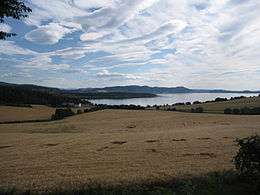
Natural resources
Steinkjer is one of Norway's larger urban municipalities measured by total area. Approximately half the population lives near the town center, while the rest live in rural areas. However, much of the town is today in the process of urbanization, with the building of several apartment blocks in or within the immediate vicinity of the town. Currently, about 500 apartments are being finished.
Steinkjer is one of the northernmost areas with rich agriculture, allowing large production of grain. It is obvious from the landscape that Steinkjer is a typical agricultural municipality. In addition, there are large forest resources in the immediate area. The tallest buildings in Steinkjer are two 40-metre (130 ft) tall grain silos, visible several kilometres south of Steinkjer and today mark the skyline, especially when viewed from the south. Kirknesvaag Sag & Høvleri is a large wood mill and industry park producing wood planks and treehouse module components. Almost half of the inner town area consists of the large industrial park for wood products. Most of the ship traffic is related to transportation of the vast forest resources present in Nord-Trøndelag such as timber and cellulose. An important tree species is Norway Spruce.
Climate
Further north from Steinkjer, geographical distances between cities grow. The climate of Steinkjer marks a border with the more harsh conditions typical of inland areas further north. The January average in Steinkjer is −5 °C (23 °F),[32] and the July 24-hr average is 14 °C (57 °F). Steinkjer has a sheltered location and is the most northern town with a summer season long enough to allow reliable cultivation of wheat. Steinkjer is therefore recognized as a "border town" between the more densely populated southern parts of Norway and the less populated northern part. Steinkjer has observed temperatures above 32 °C (90 °F), but also winter temperatures below −25 °C (−13 °F). Temperatures have tended to be warmer in recent years.
| Climate data for Steinkjer (10 last years) | |||||||||||||
|---|---|---|---|---|---|---|---|---|---|---|---|---|---|
| Month | Jan | Feb | Mar | Apr | May | Jun | Jul | Aug | Sep | Oct | Nov | Dec | Year |
| Average high °C (°F) | −1 (30) |
−1 (30) |
2 (36) |
8 (46) |
12 (54) |
16 (61) |
19 (66) |
18 (64) |
13 (55) |
7 (45) |
3 (37) |
0 (32) |
8 (46) |
| Average low °C (°F) | −5 (23) |
−6 (21) |
−4 (25) |
2 (36) |
6 (43) |
10 (50) |
12 (54) |
11 (52) |
7 (45) |
3 (37) |
−1 (30) |
−3 (27) |
3 (37) |
| Source: [33] | |||||||||||||
Birdlife
Steinkjer, with its varied habitats, provides the local birdlife with some of the best localities within the region. One of these is Lake Lømsen with its breeding population of Slavonian grebe. The surrounding woodlands and farmlands hold a host of the commoner Scandinavian species, some, like fieldfare and redwing, can be found in good numbers.
Forests and other habitats
The municipality of Steinkjer includes lowland forests, alpine forests, as well as areas above the treeline. A part of Blåfjella-Skjækerfjella National Park is located in the municipality. Byahalla,[34] the most northerly deciduous temperate forest (hemiboreal) location in the world, with species such as wych elm, hazel, hepatica, hedge woundwort, and garlic mustard, is located in Steinkjer, probably due to the sheltered south facing location and the good soil resulting from marine deposits. Some moist locations with spruce forests are classified as boreal rainforests and are part of the Scandinavian coastal conifer forests. The shallow river estuaries in the inner part of the Trondheimsfjord have some of the richest bird life in Norway; thousands of migratory birds feed here.[35] Part of Snåsavatnet, the 6th largest lake in Norway, is located in the municipality, and the river from the lake meets the fjord in the town of Steinkjer.
Transportation
Steinkjer lies about 120 kilometres (75 mi) by road north of the city of Trondheim along the European route E6 highway. The Sneppen Bridge is part of the E6 in the town of Steinkjer, crossing the river Byaelva. Norwegian County Road 17 begins in Steinkjer and heads north. This highway is often referred to as the Coastal highway, whereas the E6 runs to the north, but further inland.
Steinkjer is the home of the oldest network arch bridge in the world opened to traffic 1964. The bridge is 94 m long and takes the Nedre Mølleveg over the Steinkjerelva.[36]
The municipality is situated along the Nordland Line from Trondheim, and is served by Steinkjer Station and Sparbu Station.
Culture
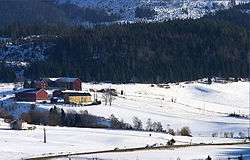
Steinkjer also has a rich culture and hosts one of the most prominent music cultures in central Norway. Steinkjer is also labeled "Steinkjer Punkrock town" by some of its citizens. The music festival Steinkjerfestivalen was established in 2006.[37] Steinkjermartnan, held each year in August, is a happening where trading booths are staged in the town centre's streets and a traditional trade festival with concerts are held.
Steinkjer has the standard cultural facilities like a cinema, town library, culture house (in which many cultural events and concerts are held), and a modern swimming pool called Dampsaga Bad. The swimming pool has a 25-metre (82 ft) long training pool plus heating pools, sauna, two learning pools for kids, and a large swim tube.
Education
Steinkjer houses the administration and Faculty of Society, Commerce, and Nature of Nord-Trøndelag University College. Important studies include the School of Forestry (Norwegian: Skogskolen). Historically, Steinkjer has produced a higher than average amount of university students. Only 25% of the students return to Steinkjer. Steinkjer is therefore a municipality that produces many people with higher education students. In Norwegian, municipalities such as Steinkjer that produce many people with higher education who leave the municipality are known as oppvekstkommuner (lit. 'upbringing municipalities').
Notable residents
- Anders Bardal (born 1982), ski jumper
- Ida Jenshus (born 1987), musician
- Ivar Asbjørn Følling (1888–1973), first scientific description of Phenylketonuria (Følling's disease)
- Jakob Weidemann (1923–2001), artist
- Kristofer Uppdal (1878–1961), poet, writer
- Silje Nergaard (born 1966), musician
References
- "Navn på steder og personer: Innbyggjarnamn" (in Norwegian). Språkrådet.
- "Forskrift om målvedtak i kommunar og fylkeskommunar" (in Norwegian). Lovdata.no.
- Statistisk sentralbyrå (2020). "Table: 06913: Population 1 January and population changes during the calendar year (M)" (in Norwegian).
- Statistisk sentralbyrå (2020). "09280: Area of land and fresh water (km²) (M)" (in Norwegian).
- Jukvam, Dag (1999). "Historisk oversikt over endringer i kommune- og fylkesinndelingen" (PDF) (in Norwegian). Statistisk sentralbyrå.
- "Bakgrunn" (in Norwegian). Nye Steinkjer. Retrieved 2017-10-01.
- Rygh, Oluf (1903). Norske gaardnavne: Nordre Trondhjems amt (dokpro.uio.no) (in Norwegian) (15 ed.). Kristiania, Norge: W. C. Fabritius & sønners bogtrikkeri. p. 225.
- "Steinkjers kommunevåpen" (in Norwegian). Retrieved 2020-02-09.
- "Civic heraldry of Norway - Norske Kommunevåpen". Heraldry of the World. Retrieved 2018-04-15.
- Norske Kommunevåpen (1990). "Nye kommunevåbener i Norden". Retrieved 13 November 2008.
- Ringdal, Nils Johan (1995). "Steinkjer". In Dahl; Hjeltnes; Nøkleby; Ringdal; Sørensen (eds.). Norsk krigsleksikon 1940-45 (in Norwegian). Oslo: Cappelen. p. 397. ISBN 82-02-14138-9.
- Hansen, Tore, ed. (2016-05-12). "kommunestyre". Store norske leksikon (in Norwegian). Kunnskapsforlaget. Retrieved 2019-01-01.
- "Tall for Norge: Kommunestyrevalg 2019 - Trøndelag". Valg Direktoratet. Retrieved 2019-10-20.
- "Table: 04813: Members of the local councils, by party/electoral list at the Municipal Council election (M)" (in Norwegian). Statistics Norway.
- "Tall for Norge: Kommunestyrevalg 2011 - Nord-Trøndelag". Valg Direktoratet. Retrieved 2019-10-20.
- "Kommunestyrevalget 1995" (PDF) (in Norwegian). Oslo-Kongsvinger: Statistisk sentralbyrå. 1996. Retrieved 2020-04-12.
- "Kommunestyrevalget 1991" (PDF) (in Norwegian). Oslo-Kongsvinger: Statistisk sentralbyrå. 1993. Retrieved 2020-04-12.
- "Kommunestyrevalget 1987" (PDF) (in Norwegian). Oslo-Kongsvinger: Statistisk sentralbyrå. 1988. Retrieved 2020-04-12.
- "Kommunestyrevalget 1983" (PDF) (in Norwegian). Oslo-Kongsvinger: Statistisk sentralbyrå. 1984. Retrieved 2020-04-12.
- "Kommunestyrevalget 1979" (PDF) (in Norwegian). Oslo: Statistisk sentralbyrå. 1979. Retrieved 2020-04-12.
- "Kommunevalgene 1975" (PDF) (in Norwegian). Oslo: Statistisk sentralbyrå. 1977. Retrieved 2020-04-12.
- "Kommunevalgene 1972" (PDF) (in Norwegian). Oslo: Statistisk sentralbyrå. 1973. Retrieved 2020-04-12.
- "Kommunevalgene 1967" (PDF) (in Norwegian). Oslo: Statistisk sentralbyrå. 1967. Retrieved 2020-04-12.
- "Kommunevalgene 1963" (PDF) (in Norwegian). Oslo: Statistisk sentralbyrå. 1964. Retrieved 2020-04-12.
- "Kommunevalgene og Ordførervalgene 1959" (PDF) (in Norwegian). Oslo: Statistisk sentralbyrå. 1960. Retrieved 2020-04-12.
- "Kommunevalgene og Ordførervalgene 1955" (PDF) (in Norwegian). Oslo: Statistisk sentralbyrå. 1957. Retrieved 2020-04-12.
- "Kommunevalgene og Ordførervalgene 1951" (PDF) (in Norwegian). Oslo: Statistisk sentralbyrå. 1952. Retrieved 2020-04-12.
- "Kommunevalgene og Ordførervalgene 1947" (PDF) (in Norwegian). Oslo: Statistisk sentralbyrå. 1948. Retrieved 2020-04-12.
- "Kommunevalgene og Ordførervalgene 1945" (PDF) (in Norwegian). Oslo: Statistisk sentralbyrå. 1947. Retrieved 2020-04-12.
- "Kommunevalgene og Ordførervalgene 1937" (PDF) (in Norwegian). Oslo: Statistisk sentralbyrå. 1938. Retrieved 2020-04-12.
- "Kommunevalgene og Ordførervalgene 1934" (PDF) (in Norwegian). Oslo: Statistisk sentralbyrå. 1935. Retrieved 2020-04-12.
- "Normaler for Steinkjer". Met.no.
- "Steinkjer average conditions - base period 10 last years". Storm Weather Center. Retrieved 3 December 2009.
- "Miljøstatus - Nord-Trøndelag".
- "Inner Trondheimsfjord wetland system".
- Tveit, Per (2006). "An Introduction to the Network Arch" (PDF).
- "Steinkjerfestivalen 2009".
External links
| Wikimedia Commons has media related to Steinkjer. |

- Municipal fact sheet from Statistics Norway (in Norwegian)
- Dampsaga Culture House - houses public library, concert hall and cinema of Steinkjer (in Norwegian)
- Steinkjer2007.no (in Norwegian)
- Steinkjer.net - recent news about commerce and business in Steinkjer (in Norwegian)
- Webcameras showing Steinkjer (in Norwegian)
- Steinkjerx.net - A database with articles and pictures about Steinkjer

